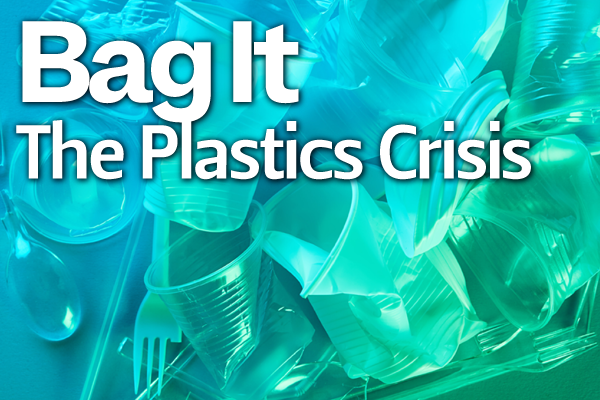Biden Administration Backs Plastic as Coal Replacement to Make Steel. One Critic Asks: ‘Have They Lost Their Minds?’
Jane Williams read the announcement with dismay.
A Pennsylvania company was getting tens of millions of dollars in federal loan guarantees to turn plastic waste into a fuel for steelmaking, claiming the climate would benefit.
“This is one of the craziest ideas I’ve seen,” Williams said of the business plan by Erie-based International Recycling Group. Williams leads the environmental group California Communities Against Toxics, chairs the Sierra Club’s national clean air team and has worked on the technical aspects of environmental regulations for decades. “Have they lost their minds?”
She is among more than 100 representatives of environmental and community groups, including Beyond Plastics, Greenpeace and the Natural Resources Defense Council, to this week call on U.S. Department of Energy Secretary Jennifer Granholm to reverse the agency’s July decision to commit $186.2 million of Inflation Reduction Act funding to International Recycling Group.
Explore the latest news about what’s at stake for the climate during this election season.
That commitment is conditional: The company’s plans must undergo an environmental review and meet other financial and technical requirements. The Energy Department asserts that swapping out coke, a coal-derived fuel, in blast furnaces used to make steel will reduce global heat-trapping emissions.
But in their Aug. 26 letter to Granholm, the groups asserted that “burning plastic in place of coal is not a climate solution, it merely substitutes one form of fossil fuel with another.”

Further, Williams said she does not accept the company’s claims that the plastic fuel it wants to make, dubbed CleanRed, won’t add to the already potent toxic air emissions associated with steel production.
“There are no steel mills in the United States that burn plastic,” said Williams, who spent the last four years closely following and commenting on new Environmental Protection Agency air quality regulations on the steel manufacturing industry. “No one has any idea what the emissions profile of burning plastic will be.”
The Energy Department defended its decision to support the proposal, which also includes the construction of a large plastic waste sorting and processing plant in Erie with plans to collect plastic from as far as 750 miles away.
An agency spokesman said the company’s plans align with the Energy Department’s “mandate to deploy innovative technologies that decarbonize our economy while ensuring that the benefits of investments flow to surrounding communities.”
“No one has any idea what the emissions profile of burning plastic will be.”
The spokesman said the project “reinforces President Biden’s Investing in America agenda to create good-paying, high-quality job opportunities in communities across the country and ensure workers benefit from America’s growing clean energy economy.”
For his part, Mitch Hecht, the chairman of International Recycling Group, described his befuddlement at the recent criticism of his company’s plans.
“We are completely baffled by what appears to be a national campaign to attack all plastic recycling,” Hecht said. “It makes absolutely zero sense from any true environmentalist perspective that we are going to just prefer to stop the effort to recycle more plastic.”
A Benefit to Disadvantaged Communities, or a Blow?
Last year, the Energy Department said in a notice to prepare an environmental assessment that the fuel made from plastic waste at the proposed Erie plant would go to the U.S. Steel plant in Gary, Indiana.
But now the agency describes its destination only as a steel mill in northwest Indiana, which is where Gary is located, and where its plant is among the nation’s largest polluters.
U.S. Steel this week declined to tell Inside Climate News whether it was making plans to accept the plastic waste. And Hecht declined to comment on where he plans to send the material.
Regardless, Gary residents with the groups Gary Advocates for Responsible Development, which played a central role in fighting a now-dropped plan to turn trash and plastic into jet fuel, and Just Transition Northwest Indiana joined their environmental colleagues in signing the letter.

“Using plastic pellets in the blast furnace iron-producing process not only creates a new and untested environmental hazard in steel mill fence-line communities, but it also threatens steelworker jobs and the sustainability of the mill itself by delaying investments in newer green technologies,” said Dorreen Carey, president of Gary Advocates for Responsible Development.
Among those emerging technologies are those using hydrogen and electricity.
In Erie, Pennsylvania, local residents have been debating the potential merits or environmental problems associated with the plastics proposal since it was announced in 2020.
The project has support from local government and at least two state lawmakers, Reps. Pat Harkins and Bob Merski, both Democrats. They said in a July press release that it would create more than 300 jobs and thanked the Biden-Harris administration for backing the Erie project. The announcement was made in an election year amid a pitched battle over a vital swing state in the presidential race.
Merski called the announcement “a beacon of hope for a cleaner, greener future.” Harkins said: “This substantial investment would catalyze the construction of a state-of-the-art plastics recycling facility, positioning Erie as a national leader in sustainable practices and innovation.”
But Russell Taylor, a retired social studies teacher from Erie, said he’s not opposed to recycling plastic but is worried about the size and scale of the planned facility, increased truck traffic, fire risks and the possibility of microplastic particles from the plant getting into nearby Lake Erie.
Taylor, a spokesman for the local group Our Water, Our Air, Our Rights, also questions the company’s business plan. He said he doubts other communities are going to want to give up the types of plastic waste that can more easily be recycled and have a higher commercial value. That would mean only the hardest-to-recycle, lowest-quality plastic waste would come to Erie, he said.
Already, the letter from environmentalists to Granholm has drawn national attention to his group’s concerns, Taylor said.
“There are so many better ways to spend $182 million to work on the environment,” Taylor said. “What is attractive about this?”

The Energy Department in a press release announcing the loan guarantee touted the plan’s consistency with Biden’s Justice40 initiative, created by executive order in 2021. That directs federal agencies to deliver 40 percent of the “overall benefits” of their environmental and energy investments to “disadvantaged communities that have been historically marginalized and overburdened by pollution and underinvestment.”
The agency noted that the Erie plant would be located in a disadvantaged community and “the steel manufacturer is also located in a disadvantaged community.”
The environmental groups agreed in their letter that the “Erie and Gary communities are historically underserved, yet this project threatens to worsen public health issues they already endure.”
Permit Application Deficiencies Found
In a permit application to the Pennsylvania Department of Environmental Protection, the company says the plant will collect as much as 160,000 tons of plastic waste a year. That’s enough to fill as many as 8,000 20-ton trucks.
Bales of the incoming plastic waste, according to the application, would be sorted, cleaned and in certain cases extruded into pellets to be sold to customers for mechanical recycling, typically a process that heats and molds waste plastic into new plastic products.
In all, the company plans to produce about 100,000 tons of plastic pellets per year this way, the Energy Department said.
The plan also calls for producing 20,000 tons of CleanRed in a process the permit application said involves shredding plastic and removing contaminants. The coke substitute would be stored in silos and then shipped out to customers in tank trucks or rail cars, according to the application.
International Recycling Group’s permit application describes the Erie plant as a minor source of particulate pollution, the often too-small-to-see particles that are easily inhaled and harm people’s health. Pennsylvania regulators are asking for more information to justify that category.
On Aug. 12, the state environmental protection department wrote to the company, saying its application was technically deficient. It asked for a clarification of its proposed emissions limits and an explanation of why certain pollution control technologies were not feasible.
The Energy Department said it will need to complete an environmental analysis of the project under the National Environmental Policy Act before any money is released. It’s put that study on hold until the company gets further along on its permitting process with the state.
“This is an operation that includes shredding, among other things,” said Alex Bomstein, executive director of the Clean Air Council, a Pennsylvania-based nonprofit advocacy group. “It also involves a lot of truck traffic. Both of those create particles that get suspended in the air, and workers inside the facility may breathe in those particles. People living in the nearby community may breathe in those particles.”
He said he’s also concerned about the potential release of hazardous air pollutants because of the nature of plastic. It’s made from thousands of chemicals, many of them toxic.
“Another concern that we have is the labeling of this quote-unquote CleanRed product, which is just shredded residual waste,” Bomstein said. “It is not an innovative product. People have been burning trash for many, many years. This is just that.”
Hecht said the “notion that we are burning plastic is false.” The material, he said, is “consumed” or “vaporized” inside a furnace at more than 3,000 degrees Fahrenheit in what he called a “chemical process.”
There are steel mills in Japan and Europe that use plastic as a coke substitute, with real carbon dioxide emission reductions, Hecht said. He declined, however, to provide a copy of the environmental study upon which he bases the climate benefits of steel mills using his product.
“It is not an innovative product. People have been burning trash for many, many years. This is just that.”
The Energy Department said U.S. steel production accounts for 7 percent of national greenhouse gas emissions. Assuming a 14 percent replacement rate of coking coal used in blast furnaces, the plastic fuel will result in a 24 percent reduction in greenhouse gases from this process, the agency said.
It, too, declined to provide what the agency spokesman described as an “internal” analysis behind that claim.
Judith Enck, a former EPA regional administrator and founder and president of Beyond Plastics, isn’t accepting the Energy Department’s climate justification.
The future of low-carbon steel-making isn’t with plastic waste, and the Energy Department knows that, Enck said. She noted that the head of the agency in March announced $6 billion in funding from the Inflation Reduction Act, or IRA, for 33 commercial-scale demonstration projects to decarbonize energy-intensive industries, including steel manufacturing.
Granholm visited Middletown, Ohio, for that announcement. There, Cleveland-Cliffs, a steel manufacturer, is to get $500 million to retire a coke-fired blast furnace in a switch to new electric technology with hydrogen.
“Using IRA money to prop up blast furnaces is not consistent with other funding decisions by the DOE,” Enck said. “If finalized, this project would make plastics the new coal. IRA money is supposed to be used to improve the environment, not worsen it.”
About This Story
Perhaps you noticed: This story, like all the news we publish, is free to read. That’s because Inside Climate News is a 501c3 nonprofit organization. We do not charge a subscription fee, lock our news behind a paywall, or clutter our website with ads. We make our news on climate and the environment freely available to you and anyone who wants it.
That’s not all. We also share our news for free with scores of other media organizations around the country. Many of them can’t afford to do environmental journalism of their own. We’ve built bureaus from coast to coast to report local stories, collaborate with local newsrooms and co-publish articles so that this vital work is shared as widely as possible.
Two of us launched ICN in 2007. Six years later we earned a Pulitzer Prize for National Reporting, and now we run the oldest and largest dedicated climate newsroom in the nation. We tell the story in all its complexity. We hold polluters accountable. We expose environmental injustice. We debunk misinformation. We scrutinize solutions and inspire action.
Donations from readers like you fund every aspect of what we do. If you don’t already, will you support our ongoing work, our reporting on the biggest crisis facing our planet, and help us reach even more readers in more places?
Please take a moment to make a tax-deductible donation. Every one of them makes a difference.
Thank you,
David Sassoon
Founder and Publisher
Vernon Loeb
Executive Editor
Share this article
Disclaimer: The copyright of this article belongs to the original author. Reposting this article is solely for the purpose of information dissemination and does not constitute any investment advice. If there is any infringement, please contact us immediately. We will make corrections or deletions as necessary. Thank you.








